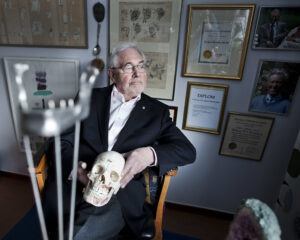Even as a child, you were probably bending metal. You might have been bending metal paper clips, or even your parents' cutlery. Or you might have preferred making pipe-cleaner clowns. Or you could have just stuck to bending the toothpaste tube (They were metal back then, weren't they?). One thing is for certain, the metal you were bending as a child was not steel beams or tubes, and it never had to be strong enough to hold up a stadium roof or a roller coaster.
As adults, we rely on curved metal beams, pipe, tubes, and angles in everything from a simple park bench to spiral staircases to some parts of modern skyscrapers. Visit any airport or museum built in the past couple decades and count the number of curved metal structures you find.
Have you ever wondered how they do it? I mean, how can you bend a steel beam and still keep the strength to support an airport roof? Well, there are four ways.
Rolling to bend metal
Rolling is the best known way to bend metal, perhaps because it is the least costly. Rolling uses an appropriate size die that adjusts to the steel tube, angle, pipe, channel, bar or steel beam and revolves at the same peripheral speed, turning in opposite directions. As the metal passes through the roll, the machine applies pressure to bend the tubing or the beam to the desired radius.
Rolling is effective when the material - metal, plastic, glass, whatever - must be bent a great deal. For instance, it can produce bends up to 360 degrees. This method is ideal for producing steel coils, spiral staircases and the like.
There are different kinds of rolling processes. Hot rolling (above the recrystallization temperature) mostly produces sheet metal. Most non-ferrous metal structures are rolled cold, but steel is usually rolled hot.
Because rolling requires less set-up work and uses pre-made dies, the cost is less than other ways to bend and form steel, so companies often choose this when it suits their specifications.
Mandrel to bend metal
Mandrel bending is also fairly well known. In this process, a metal shaft, or mandrel, is fitted inside the steel tube or pipe. As the mandrel moves, it bends the metal around the appropriate sized die to form the radius.
Mandrel works best when the steel tube or pipe has a heavy wall and/or requires a tight radius because it prevents the material from rippling. Mandrel can only bend steel tubing up to 180 degrees, but it produces a bend that is uniform all the way up and down the pipe or tube. Obviously, this process is of little use for bending metal beams or sheets, however, it is used in bending exhaust pipes, molten glass and in very tiny cases, jewelry.
Press to bend metal
The Press method is the third way to bend metal. The steel tube, pipe, channel, bar or steel beam is fed through the press, which applies pressure every 6 or 7 inches until the material is bent to specifications
Press is used to bend bigger, heavier beams, pipes, channels, bars or tubes (24 inches or thicker) that do not require a very tight radius.
This is a less common process than rolling or mandrel. However, it is capable of producing large, load-bearing steel support beams used for schools, roofing, skyscrapers, gymnasiums, malls and bridges.
Table forming to bend metal
Table forming is the fourth process. The steel tube, pipe, or beam is laid out straight and the ends are pulled around the appropriate sized die to form the radius.
Table forming is used primarily to bend smaller, heavier steel tubes, pipes, channels, bars or steel beams that require a tight radius.
But if all that metal bending is too much for you, pick up those pipe cleaners and wow your kids with the colorful pipe-cleaner clowns you can form by bending metal at home.





Comments